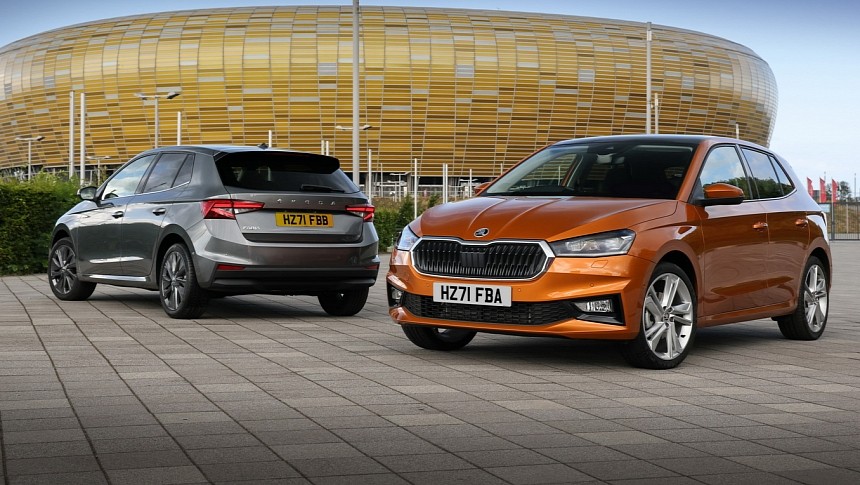Klaus Zellmer was promoted to the post of chief executive officer of Skoda in July 2022. With a bit of luck, his tenure won't come to a close by July 2025, when Euro 7 regulations are expected to go into effect.
Said regulations present a huge challenge for both Zellmer and the company he runs. For example, sister brand Volkswagen considers axing the Polo subcompact hatchback in favor of an electric model. The potential successor has already been previewed by the ID2.all concept, which rocks a front-mounted electric motor and the MEB Entry platform for entry-level electric vehicles.
The European Commission, which is full of peeps who don't really understand the realities of the automotive industry, estimates that Euro 7 regulations will add a few hundred euros to the price of a new vehicle. ACEA, which stands for the European Automobile Manufacturers' Association, estimates up to 2,000 euros (2,205 dollars) more than equivalent Euro 6 vehicles. Volkswagen brand chief executive officer Thomas Schafer estimates a simply ludicrous €5,000 ($5,510).
Increased regulatory costs and the already high starting prices of B-segment vehicles may spell the bitter end for the Fabia. The chief executive officer of Skoda made it clear that the current draft for Euro 7 defeats the purpose of the Fabia altogether. Speaking to British publication Autocar, the man in charge does have a point. Would you spend 20,000 pounds sterling (25,000 dollars) or more for a B-segment hatch? Neither would Zellmer.
The European Commission is certainly downplaying the actual expenses that automakers will incur with the advent of Euro 7, and – to be frank – automakers tend to dramatize such things with obvious reasoning. Whatever the actual regulatory costs may be, it's also evident that young potential customers and families with modest incomes are being squeezed out of new car ownership.
If there's no demand for a brand-new Fabia, why should the Czech automaker spend millions over millions of euros on developing the next generation? Financially speaking, redirecting those resources into a Skoda-branded sibling of the ID.2all makes far more sense.
New electric vehicles aren't particularly affordable either given the production costs of their batteries in particular. But as opposed to internal combustion-engined vehicles, the zero-emission alternative comes with a few perks. Think free parking, dedicated lanes, and – most importantly – government incentives.
This honeymoon isn't going to last forever, though. EV adoption will reach a point of no return if things continue as they are now, and exactly at that point, governments across the European Union will stop granting taxpayers' money for ditching fossil-fuel vehicles for EVs.
Don't believe me? Just look at Norway, where nearly 80 percent of new car sales in 2022 consisted of battery-electric vehicles. Back in January 2023, the Scandinavian country implemented a 25-percent VAT on new EVs that cost more than 500,000 kroner. More specifically, the value-added tax applies to the excess amount over 500,000 kroner, which means roughly $47,085.
The more dramatic change, however, is the weight tax. Previously applicable to fossil-fuel vehicles – including hybrids – the weight tax applies after the first 500 kilograms (1,102 pounds) of an electric vehicle's curb weight. The gist of it is that Norwegian customers of the Tesla Model X Plaid are charged an extra 26,300 kroner ($2,475).
On that note, a question must be posed: Would you be sorry to see the Fabia go in favor of an electric hatchback?
The European Commission, which is full of peeps who don't really understand the realities of the automotive industry, estimates that Euro 7 regulations will add a few hundred euros to the price of a new vehicle. ACEA, which stands for the European Automobile Manufacturers' Association, estimates up to 2,000 euros (2,205 dollars) more than equivalent Euro 6 vehicles. Volkswagen brand chief executive officer Thomas Schafer estimates a simply ludicrous €5,000 ($5,510).
Increased regulatory costs and the already high starting prices of B-segment vehicles may spell the bitter end for the Fabia. The chief executive officer of Skoda made it clear that the current draft for Euro 7 defeats the purpose of the Fabia altogether. Speaking to British publication Autocar, the man in charge does have a point. Would you spend 20,000 pounds sterling (25,000 dollars) or more for a B-segment hatch? Neither would Zellmer.
The European Commission is certainly downplaying the actual expenses that automakers will incur with the advent of Euro 7, and – to be frank – automakers tend to dramatize such things with obvious reasoning. Whatever the actual regulatory costs may be, it's also evident that young potential customers and families with modest incomes are being squeezed out of new car ownership.
If there's no demand for a brand-new Fabia, why should the Czech automaker spend millions over millions of euros on developing the next generation? Financially speaking, redirecting those resources into a Skoda-branded sibling of the ID.2all makes far more sense.
New electric vehicles aren't particularly affordable either given the production costs of their batteries in particular. But as opposed to internal combustion-engined vehicles, the zero-emission alternative comes with a few perks. Think free parking, dedicated lanes, and – most importantly – government incentives.
This honeymoon isn't going to last forever, though. EV adoption will reach a point of no return if things continue as they are now, and exactly at that point, governments across the European Union will stop granting taxpayers' money for ditching fossil-fuel vehicles for EVs.
Don't believe me? Just look at Norway, where nearly 80 percent of new car sales in 2022 consisted of battery-electric vehicles. Back in January 2023, the Scandinavian country implemented a 25-percent VAT on new EVs that cost more than 500,000 kroner. More specifically, the value-added tax applies to the excess amount over 500,000 kroner, which means roughly $47,085.
The more dramatic change, however, is the weight tax. Previously applicable to fossil-fuel vehicles – including hybrids – the weight tax applies after the first 500 kilograms (1,102 pounds) of an electric vehicle's curb weight. The gist of it is that Norwegian customers of the Tesla Model X Plaid are charged an extra 26,300 kroner ($2,475).
On that note, a question must be posed: Would you be sorry to see the Fabia go in favor of an electric hatchback?







































